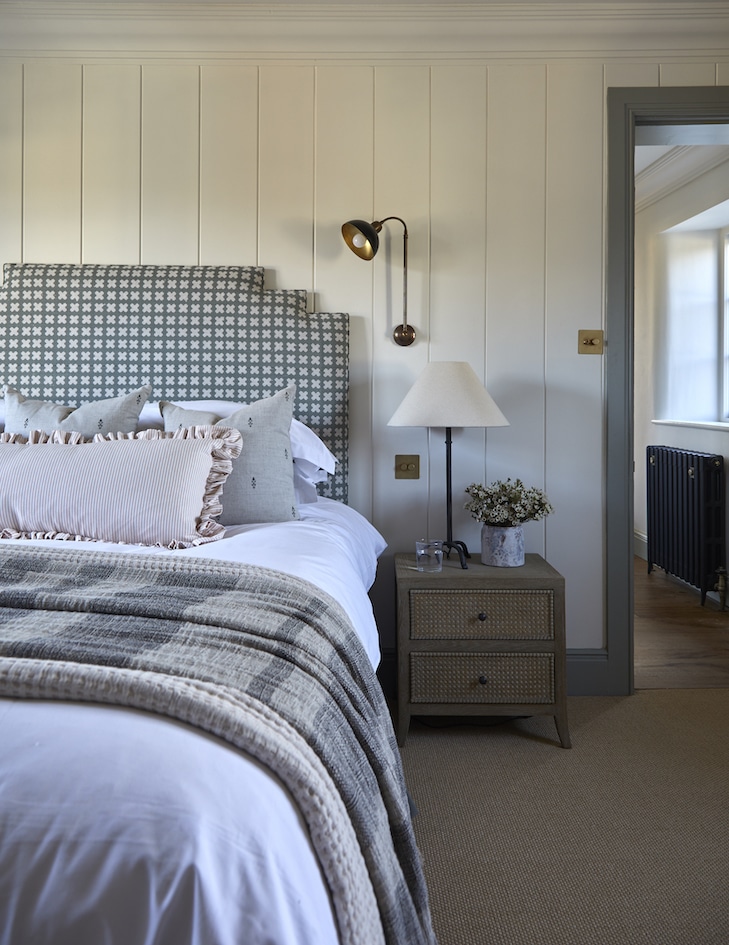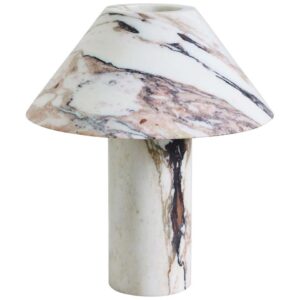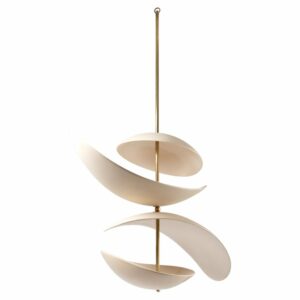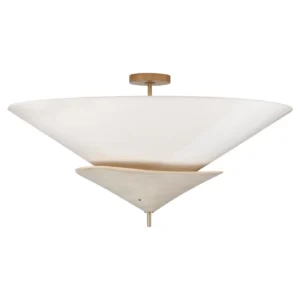
Millie Turner

Millie Turner is the founder of Millie Turner Designs, a boutique full-service design studio based in London, working on projects across the UK. What began as a freelance career evolved into a fully-fledged studio in 2020 at the start of the pandemic. Since then, Millie has grown the business to a team of six, delivering a diverse range of projects. Her design approach blends timeless and contemporary elements, crafting homes that feel warm, personal, and effortlessly lived-in. With a love for layering textures, natural materials, and playful pops of colour, she creates spaces that are both functional and inviting—never cold or staged, always full of life and personality. At Millie Turner Designs, it’s not just about interiors—it’s about creating spaces that tell a story.
1. Could you tell us how your journey into interior design started?
My path into interior design was quite unexpected. In 2018, my husband and I took on our first renovation project, which became a real passion project for me. I’ve always been more creatively inclined than academic, with a strong eye for colour and detail, so I threw myself into the process and started sharing the journey on social media. Before I knew it, my following had grown from zero to 10,000 in just a few weeks—long before viral reels made that kind of growth easy! Suddenly, people were messaging me, asking if I was a designer and if I could help with their homes. At the time, I wasn’t even thinking about design as a career—I was just excited to create a home I loved. As the renovation progressed, I wanted to refine my skills, so I took design courses and learned CAD software. That’s when things really shifted. I found myself enjoying the process far more than my actual job, and by the time we finished our project, I realised this was something I wanted to pursue properly. Since people were already asking for help, I decided to start taking on small design projects, working with different styles and client briefs to gain hands-on experience.
At the same time, I began freelancing for design studios, helping with CAD drawings and 3D visualisations. This gave me a great insight into how the industry worked behind the scenes, and before long, it was clear that design was my future. After a year of balancing both my full-time job and my growing design work, I finally took the leap and set up my own business. I started with Virtual Design (E-Design), which allowed me to work with clients all over the world, while honing my skills across different spaces and styles. As the business grew, we moved into Full-Service Design, managing projects from concept to completion. A couple of years ago, we introduced our Hybrid Service, which offers a more flexible approach—bridging the gap between virtual and full-service design while still giving clients a high level of support. Today, we’re a team of six (soon to be seven), and the business continues to evolve. It’s been a challenging but rewarding journey, and I wouldn’t change a thing.
2. Do you think there has been a defining moment in your career?
One that stands out is a project we worked on in 2023, a beautiful cottage in the Cotswolds. It was the first time I felt like a project truly reflected my own style and love of colour and pattern. We were incredibly lucky to have clients who shared our vision and gave us almost complete creative freedom, which is quite rare! The project was a huge success and has since been featured in several magazines, blogs, and other publications. I’m really proud of it—not just because of how it turned out, but because it marked a turning point for the business. Before this, most of our clients leaned towards a more neutral aesthetic, whereas colour and pattern has always been my true passion. Putting this project out into the world has led to more opportunities to work on playful, vibrant spaces, which is something I’m really excited about!


3. What do you think is the key to a successful interior design? And in your business in general?
Hard work and a thick skin! I think people often underestimate just how relentless this job can be. From the outside, it probably looks like a dream job 24/7—and don’t get me wrong, I absolutely love what I do. With the right client and project, it doesn’t even feel like work. But the reality is, there’s a huge amount of pressure and stress behind the scenes. Running your own business, especially in the early years, means making a lot of sacrifices. For me, it took about three to four years before I started getting my weekends back!
Having a thick skin is essential to be successful. Interior design is deeply personal, and no matter how skilled or experienced you are, there will always be moments where you don’t see eye to eye with a client. Not every project is a perfect match, and learning how to navigate difficult conversations, manage expectations, and not take things personally is a crucial skill one that took me a long while to learn myself. Over time, you develop the confidence to stand by your expertise while still keeping clients happy. Without resilience and the ability to handle challenges head-on, I don’t think you’d make it in this industry—it’s far tougher than I ever imagined when I first started. Beyond that, having solid, watertight processes is essential. I was a bit late to the game with this, but since putting them in place, everything has become so much smoother—for both me and my clients. It makes a huge difference in avoiding unnecessary stress and ensuring projects run seamlessly. My background before interior design was in hospitality, which I think has helped massively. Interior design isn’t just about creating beautiful spaces—it’s about delivering a great client experience, managing expectations, and problem-solving. That balance between creativity and service is what makes a project truly successful.
4. How do you start your interior design projects? Do you usually start with a certain element of design or a keyword? And how do they develop?
Our approach depends on the project. We offer a range of services, from full-service turnkey design—where we manage everything from start to finish—to more collaborative options that involve significant client input. Typically, I begin by creating mood boards for each room to establish a clear design direction. These serve as a constant reference point throughout the process. If I come across a standout piece—whether it’s a piece of art for a living room or a vintage rug that feels essential—I’ll aim to get client approval early on and build the scheme around it. Our designs evolve from mood boards to sketches and concept development, eventually leading to detailed room renders. One of my favourite phases in a full-service project is the presentation, where we review fabrics, tiles, wall coverings, and other materials in person for final sign-off. It’s a hands-on, immersive stage that brings the vision to life.
5. How would you define your signature style? Do you have “a mantra” that encapsulates your taste in design?
Our design style is all about striking the balance between timeless and contemporary—creating homes that feel warm, characterful, and effortlessly lived-in. We love layering textures, incorporating natural materials, and introducing playful pops of colour to bring depth and personality to a space. Functionality is just as important as aesthetics, so our interiors are always designed to be inviting and practical, never overly polished or staged. Ultimately, a home should feel like an extension of the people who live there—full of life, comfort, and personality.
6. Could you tell us about one of the favorite projects that you worked on?
The project I mentioned earlier—the Cotswolds cottage—would definitely be at the top of my list. Projects feel a bit like children—you probably have a favourite, but you’re not really supposed to say! But that one just ticked every box. The clients were fantastic, the budget allowed us to be really creative, and the brief aligned perfectly with our style. What makes it even more special is that it’s a holiday rental, so I’ve had the chance to stay there a few times since completing it, showing it off to friends and family which has been a real highlight.
7. What would be your advice to beginner interior designers?
Get as much hands-on experience as possible. Theory and design principles are important, but nothing compares to real-world experience. Whether it’s working on your own home, assisting other designers, or taking on small projects, the more you do, the more you learn.
Learn how to set boundaries early on. When you’re starting out, it’s easy to overcommit, undercharge, or let projects take over your life. But setting clear boundaries—from working hours to project scope—will protect your time, energy, and creativity in the long run.
Build relationships, not just a portfolio. Your reputation and client experience matter just as much as your design skills. Treat every project as an opportunity to build trust, because referrals and repeat clients will be the foundation of your business. Suppliers, tradespeople, and fellow designers are also key connections—strong relationships within the industry can open doors you never expected.
Invest in learning. Whether it’s improving your CAD skills, understanding project management, or staying on top of industry trends, never stop learning. The best designers evolve with time and experience.
Most importantly—be patient. Success doesn’t happen overnight, and every project, good or bad, teaches you something valuable.
8. What was one of the hardest learned lessons in your journey?
Not every project—and not every client—is the right fit, which was a tough lesson for me to learn, when the fit isn’t right, the client relationship can be the most challenging part of a project. From the start, I knew I never wanted to grow into a huge firm—I always wanted to keep things relatively small and maintain a personal connection with our clients. Many of our past clients have become friends, and I’ve realised that working with people you genuinely click with on a personal level makes the entire process so much more enjoyable—for both the designer and the client. It’s taken several years to get to a point where we can be selective about the projects we take on, and I feel incredibly fortunate for that. Being able to choose projects that align with our style and values has made all the difference in the way we work and the kind of spaces we create.


9. What are your 3 favorite pieces from the Philia Collection?
10. What was the best advice you have received in your path?
One piece of advice that has really stuck with me is: “You can’t be everything to everyone.” When I first started out, I wanted to say yes to everything—every project, every client, every request—because I felt like I had to. But over time, I realised that trying to cater to everyone was not only exhausting but also diluted my design identity. The moment I became more intentional about the projects I took on, and focused on the type of work I truly loved, everything started to fall into place.
Another great piece of advice I was given is that process is just as important as creativity. As a designer, it’s easy to get caught up in the creative side, but having strong, structured processes in place is what makes a business sustainable. Learning to prioritise both has been a game-changer for me.
11. Are there any books/podcasts you would like to recommend to our readers?
Absolutely! There are so many great resources out there, but here are a few that I’ve found really valuable:
Books
- “The Interior Design Handbook” by Frida Ramstedt
- “Mad About the House” by Kate Watson-Smyth
Podcasts
- “The Business of Design Podcast”
- “The Interior Collective” by IDCO Studio
12. Finally, what are your upcoming projects? Anything you’d like to share or add to the interview?
We’re thrilled to be expanding further into Europe this year with a Ski Chalet project that I’m particularly excited about. In addition, we have a couple of commercial opportunities in the pipeline that I’m hopeful will come to life this year! These will be a first for us and mark the beginning of an exciting new chapter for MTD as we step into the world of hospitality design which has been a dream of mine since I first started my design career.

Thank you so much Millie!



